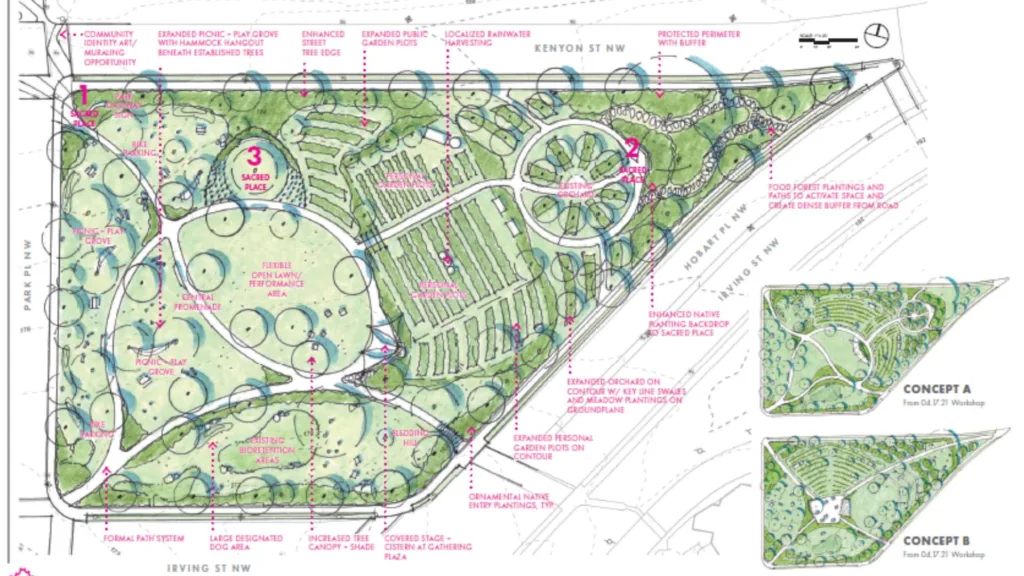Planning a community garden is a rewarding venture that can transform empty lots into vibrant spaces of growth, learning, and community bonding. However, the journey from concept to cultivation involves several critical steps, particularly regarding legal, financial, and design considerations. In the first post of this three-part series, we explored some of the reasons for starting a community garden. This post explores these aspects to provide you with a comprehensive understanding and tools to establish a flourishing community garden.
Legal and Administrative Considerations
Understanding Zoning Laws and Regulations
Before you plant your first seed, it’s crucial to understand the local zoning laws and regulations that govern land use in your area. Zoning ordinances can significantly impact the feasibility of your community garden, dictating where it can be located and what activities are permissible. Engaging with local planning departments early in your project can help navigate these regulations and ensure your garden complies with all legal requirements.
Securing Necessary Permits and Permissions
Depending on the scope of your garden and its activities, you may need to obtain various permits and permissions. These can range from land use permits and building permits for structures like sheds or greenhouses to water use permits if your garden requires a dedicated irrigation system. Collaborate closely with municipal authorities and landowners to understand and fulfill these requirements, ensuring your garden’s operations are legally sound.
Choosing a Legal Structure
Deciding on a legal structure for your community garden, such as a nonprofit organization, a community group, or a cooperative, is essential for formalizing operations, managing finances, and limiting liability. This decision will affect fundraising abilities, governance, and how the garden interacts with the community at large. Consulting with legal and financial advisors can provide guidance tailored to your garden’s specific needs and goals.
Developing Garden Agreements and Rules
A clear set of garden agreements or rules is vital for maintaining order, safety, and cooperation among gardeners. These guidelines should cover plot allocation, maintenance expectations, dispute resolution, and any community-specific rules, such as composting or water usage policies. Involve future gardeners in the creation of these rules to ensure they are fair, clear, and accepted by all.
Fundraising and Budgeting
Estimating Startup and Operational Costs
Begin by identifying all possible costs associated with starting and maintaining your garden. This includes one-time expenses like land preparation and infrastructure setup (e.g., raised beds, fencing, irrigation) and recurring costs such as water, supplies, and insurance. Accurately estimating these costs will form the backbone of your financial planning.
Exploring Fundraising Options
With a clear understanding of your budget, explore various fundraising avenues to cover these costs. Grant applications, community fundraisers, donations from local businesses, and crowdfunding campaigns are effective strategies. Transparently communicating the purpose and benefits of your garden can attract more support from your community and beyond.
Creating a Financial Plan
A detailed financial plan is essential for the sustainability of your community garden. This plan should include your startup costs, projected operational expenses, and potential income sources, such as membership fees or produce sales. Regular financial reviews can help adapt to any changes and ensure the garden remains a viable community asset.
Seeking Partnerships and Sponsorships
Forming partnerships with local businesses, schools, and non-profits can provide additional resources and support. These collaborations can offer financial backing, in-kind donations, or volunteer support, enriching your garden project. Identifying organizations that share your garden’s values and goals can lead to fruitful and long-lasting relationships.

Designing Your Community Garden
Planning Your Garden Layout
A well-thought-out garden layout is essential for maximizing your space and ensuring accessibility for all community members. Consider the needs and desires of your gardeners when designing the layout, incorporating elements like paths, communal spaces, and individual plots to create a welcoming and functional environment.
Emphasizing Accessibility, Aesthetics, and Functionality
Your garden should be a space where everyone feels welcome. Designing for accessibility ensures that gardeners of all ages and abilities can participate. Aesthetically pleasing elements like flower beds, art installations, and seating areas can make the garden a community landmark, while functional design aspects like water access and storage solutions support the garden’s day-to-day operations.
Choosing the Right Plants and Features
Selecting plants that thrive in your local climate and soil conditions is key to a bountiful garden. Encourage a mix of edible and ornamental plants, native species, and pollinator-friendly flowers to create a diverse ecosystem. Features like raised beds, trellises, and composting areas can enhance the functionality and sustainability of your garden.
Incorporating Sustainable Practices
Adopting sustainable gardening practices is not only good for the environment but also for your community. Practices like composting, rainwater harvesting, and organic gardening can reduce waste, conserve resources, and ensure a healthy, productive garden. By educating community members and gardeners about these practices, you can foster a culture of sustainability that extends beyond the garden.
- Composting provides an excellent way to recycle kitchen and garden waste into valuable soil amendments, enriching the garden’s soil and reducing the need for chemical fertilizers.
- Rainwater harvesting systems, such as rain barrels or a more complex water catchment system, can be installed to collect rainwater for garden irrigation, saving on water bills and reducing the garden’s environmental footprint.
- Organic gardening practices, including the use of natural pest controls and organic fertilizers, support the health of the soil and local ecosystems, ensuring that the garden remains a safe and chemical-free space for people and wildlife alike.
- Mulching and cover cropping are simple yet effective techniques to maintain soil health, manage weeds, and conserve moisture, further emphasizing the garden’s commitment to environmental stewardship.
Implementing these sustainable practices not only supports the ecological health of your garden but also serves as a living classroom for the community, offering educational opportunities on the importance of sustainable living.
Conclusion: Growing Together
As we wrap up our exploration of the legal, financial, and design considerations for starting a community garden, it’s clear that while the task may seem daunting, the rewards are immeasurable. Community gardens are more than just spaces for growing food; they are hubs of education, sustainability, and community spirit.
By carefully navigating the legal and administrative landscape, securing the necessary funding, and thoughtfully designing your garden, you lay the groundwork for a project that will enrich your community for years to come. Whether you’re breaking new ground or revitalizing neglected spaces, your efforts will cultivate a stronger, more connected community.
Remember, the success of a community garden is measured not just in the produce harvested but in the relationships built, the lessons learned, and the environmental impact made. With thoughtful planning and community engagement, your garden will grow into a cherished community asset, a testament to what can be achieved when we come together to create something beautiful and sustainable.
Stay tuned for the next installment in our series, where we’ll dive into the practical aspects of building, maintaining, and sustaining your community garden. Happy gardening!





